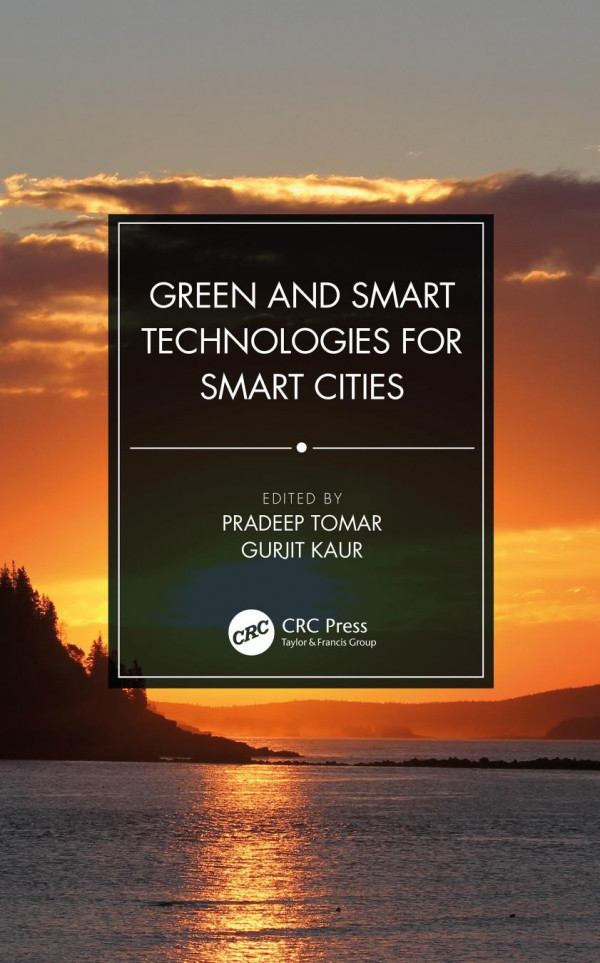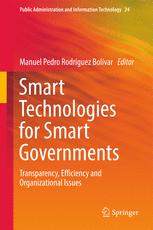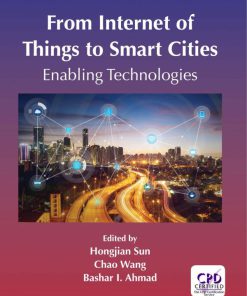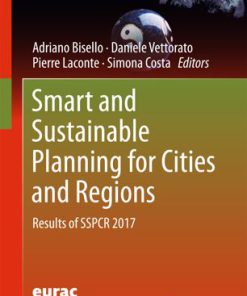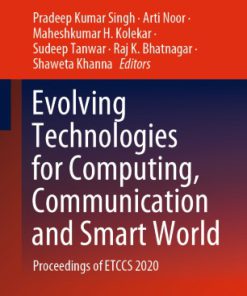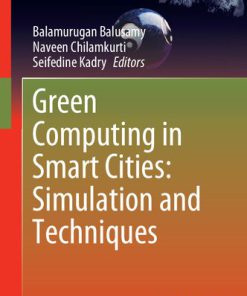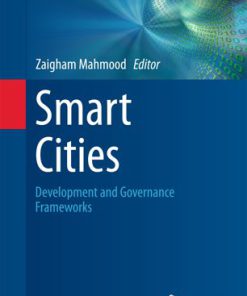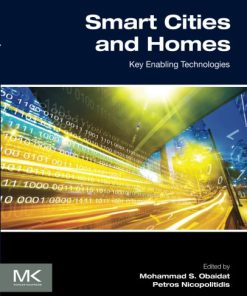Green and Smart Technologies for Smart Cities 1st Edition by Pradeep Tomar 0429846892 9780429846892
$50.00 Original price was: $50.00.$25.00Current price is: $25.00.
Green and Smart Technologies for Smart Cities 1st Edition by Pradeep Tomar – Ebook PDF Instant Download/DeliveryISBN: 0429846892, 9780429846892
Full download Green and Smart Technologies for Smart Cities 1st Edition after payment.
Product details:
ISBN-10 : 0429846892
ISBN-13 : 9780429846892
Author: Pradeep Tomar
Green and Smart Technologies for Smart Cities 1st Table of contents:
1 Green Smart Cities
1.1 Introduction
1.2 Meaning of Smart Cities
1.2.1 Secure and Safe Society
1.2.2 Mobility in Green Communication
1.2.3 Attain Excellent Education and Health
1.2.3.1 Technology-Based Learning and Teaching Approach
1.2.3.2 Personalized Teaching and Learning
1.2.3.3 Healthcare System
1.2.4 Real Estate and Building
1.2.5 Technology and Transportation Amplification
1.3 A Roadmap of Using Communication for Smart City Development
1.3.1 Green Communication-Enabled Knowledge and Information Sharing
1.3.2 Green Communication-Enabled Forecasts
1.3.3 Green Infrastructure
1.3.4 A Cloud Computing Platform
1.4 Potential Communications Technologies to Make Cities Smart
1.4.1 Wireless Technologies
1.4.2 Wired Technologies
1.5 Features of Smart Cities
1.5.1 Sensor-Equipped City and Cloud Computing
1.5.2 Future Research Directions
1.6 Conclusion
Acknowledgment
References
2 Green Smart Town Planning
2.1 Introduction
2.2 Vision of Green Smart Town Planning
2.3 Strategies and Planning Procedures for Green Smart Town Planning
2.4 Influential Factors and Policy Instruments
2.5 Basic Vital Elements for Green Smart Town Planning
2.5.1 Green Buildings
2.5.2 Green House Material
2.5.3 Green Roofs
2.5.4 Vertical Green Forests
2.5.5 Green Streets and Transportation
2.5.6 Smart Grid and Lighting
2.6 Carbon-Limiting Strategies
2.7 Challenges to Enforce the Concept of Green Smart Town Planning
Conclusion
References
3 Green Smart Buildings for Smart Cities
3.1 Introduction
3.2 Green and Smart Building Trends
3.2.1 Zero-Energy Buildings (ZEBs)
3.2.2 Building Enabled by the Internet of Things
3.3 Features of the Green Smart Building
3.3.1 Life Cycle Assessment (LCA) of a Green Smart Building
3.3.2 Structural Design Efficiency of a Green Smart Building
3.3.3 Energy Efficiency in a Green Smart Building
3.3.4 Water Efficiency in a Green Smart Building
3.3.5 Waste Reduction in a Green Smart Building
3.4 Passive Design Technologies
3.4.1 Building Envelope
3.4.1.1 The Role of Determinants in Building Envelopes
3.4.2 Building Envelope Technologies
3.4.2.1 Cool Roofs and Coatings
3.4.2.2 High-Performance Glazing
3.4.2.3 Natural Ventilation and Cooling
3.4.3 Design Factors for Passive Cooling Technologies
3.4.3.1 Orientation and Massing for Natural Ventilation
3.4.3.2 Openings for Cross-Ventilation
3.4.3.3 Wing Walls
3.4.3.4 Stack Ventilation
3.4.3.5 Solar Chimney
3.4.4 Passive Lighting or Daylighting
3.4.4.1 Methods to Efficiently Use Daylighting
3.4.4.2 Mirror Ducts and Light Pipes
3.4.4.3 Transmission of the Natural Light to Any Area
3.4.4.4 The Effect of Energy Conservation
3.4.4.5 Comfortable and Healthful Light
3.4.5 Passive Heating Technologies
3.4.6 Benefits of Passive Solar Heating
3.5 Active Design Technologies
3.5.1 Green Smart Heating, Ventilation and Air Conditioning (GSHVAC)
3.5.2 Electrical Lighting
3.5.3 Energy-Efficient Elevators
3.5.4 Plug and Process Load Management
3.6 Green Smart Building Standards and Regulations
3.6.1 Building Standards
3.6.2 Green Building Codes
3.6.3 Green Product Certification
3.7 Challenges in the Adoption of Green Smart Buildings
3.7.1 Limited Awareness
3.7.2 Insufficient Government Policies
3.7.3 Extra Approvals and Clearances
3.7.4 Poor Incentives to Motivate Adoption
3.7.5 Overpriced Equipment
3.7.6 Unskilled Manpower
Conclusion
References
4 Green Smart Environment for Smart Cities
4.1 Introduction
4.2 Green Environment
4.3 Green Products and Services
4.4 Role of Green Technologies in the Environment
4.5 Crucial Objectives of Green Science and Technology
4.6 The Six Environmental Spheres
4.6.1 The Hydrosphere
4.6.2 The Atmosphere
4.6.3 The Geosphere
4.6.4 The Biosphere
4.6.5 The Anthroposphere
4.6.6 The Sociosphere
Conclusion
References
5 Green Healthcare for Smart Cities
5.1 Green Healthcare
5.2 Green Hospitals for Smart Cities
5.2.1 Green Building Design of Hospitals in Smart Cities
5.2.1.1 Sustainable Healthcare Locations
5.2.1.2 Sustainable Hospital Building Design
5.2.1.3 Green/Living Hospital Roof
5.2.1.4 Green Area Surrounding the Hospital Building
5.2.2 Green Hospital Energy Management
5.2.2.1 Energy-efficient Hospital Products
5.2.2.2 Motion Sensor Electronics
5.2.2.3 Environment-aware Hospital Devices
5.2.2.4 Renewable Energy Resources
5.2.3 Water Management for Green Hospitals
5.2.4 Waste Prevention and Management in Healthcare
5.2.4.1 Legislative and Regulatory Healthcare Waste Policies
5.2.4.2 Healthcare Waste Minimization, Reuse and Recycling
5.2.4.3 Segregation, Storage and Transport of Healthcare Waste
5.3 Green Medical Devices for Smart Cities
5.3.1 Medical Imaging
5.3.1.1 Medical Imaging Technologies
5.3.1.2 Innovative Technologies in Medical Imaging
5.3.1.3 Recommendations for Greener Medical Imaging Equipment
5.3.2 Efficient Biomedical Signal Processing
5.3.2.1 Types of Biomedical Signals
5.4 Green Smart Digital Healthcare System
5.4.1 Electronic Healthcare Information Management System
5.4.1.1 Hospital Information Systems
5.4.1.2 Clinical Information System
5.4.1.3 Electronic Health Record
5.4.2 Telemedicine, eHealth and Telecommunications
5.4.2.1 Type of Telemedicine Solution and their Benefits
5.4.3 mHealth and pHealth Systems
5.4.3.1 Benefits of mHealth and pHealth
5.4.4 Smart Wearable Technologies for Health Monitoring
5.4.4.1 Innovative Smart Wearables and Their Benefits
5.4.5 eLearning for Green Healthcare
5.4.5.1 Benefits of eLearning in Green Healthcare
5.4.6 Modeling and Simulation Methodologies
5.4.6.1 Benefits of Simulations and their Environmental Affect
5.4.7 Intelligent Healthcare Services
5.4.7.1 Benefits of Artificial Intelligence for Green Healthcare
Conclusion
References
6 Green Smart Education System
6.1 Introduction
6.2 Overview and Evolution of a Smart Education System
6.2.1 Evolution of Smart Education
6.3 Framework for Smart Education
6.3.1 Advance Technologies for Smart Education
6.3.1.1 Cloud Computing in Education
6.3.1.2 Wireless Technology in Education
6.3.1.3 Learning Analytics
6.3.1.4 Educational Data Mining
6.3.2 Smart Learner
6.3.3 Smart Teacher
6.3.4 Smart Pedagogy
6.3.5 Smart Learning Environment
6.4 Green Computing
6.5 Green Smart Education
Conclusion
References
7 Green Smart Agriculture System
7.1 Introduction
7.2 Features of Green Smart Agriculture System
7.3 Designing of Green Smart Agriculture System
7.3.1 Smart Monitoring of Climate Conditions
7.3.2 Smart Greenhouse Automation
7.3.3 Smart Crop Management
7.3.4 Smart Cattle Monitoring and Management
7.3.5 End-to-End Green Smart Farm Management Systems
7.4 Forms of Green Smart Agriculture
7.4.1 Precision Farming
7.4.2 Agricultural Drones
7.4.3 Smart Greenhouses
7.4.4 Light-emitting Diode
7.5 Integrated Pest Management
7.5.1 Monitor and Identify Pests
7.6 Smart Green Water Management Systems
7.7 Agriculture Tourism
7.8 Precision Farming
7.9 Yield Mapping
7.10 Role of ICT for Green Smart Agriculture
Conclusion
References
8 Green Smart Security System
8.1 Introduction to the Green Smart Security System
8.2 Features of the Green Smart Security System
8.3 Technologies to Design the Green Smart Security System
8.3.1 Green RFID
8.3.2 Green Wireless Sensor Networks
8.3.3 Green Cloud Computing-based Security Systems
8.3.4 Green Machine-to-machine-based Security Systems
8.4 Security of Mobile Devices, Applications and Transactions
8.5 Smart Embedded Security for Smart Cities
8.6 Digital Identity and Access Management for Cloud-based Services
8.6.1 Advantages of Using IAM Systems
8.7 Challenges to Designing the Green Smart Security System
8.7.1 Factors that Hinder its Growth
8.7.1.1 Capital and Availability of Resources
8.7.1.2 Securing Underpowered Embedded Devices
8.7.1.3 Authentication
8.7.1.4 Manage Device Updates
8.7.1.5 Protecting Communication
8.7.1.6 Securing Data Privacy
8.7.1.7 Protection of Applications
8.7.1.8 Ensuring Adequate Availability
8.7.1.9 Identify Susceptibilities
8.7.1.10 Managing Loopholes
8.7.1.11 Anticipate Security Breaches
Conclusion
References
9 Green Smart Transport Systems
9.1 Introduction
9.1.1 Identification of Problem
9.1.2 Need for Smart Green Transportation
9.1.2.1 Degradation from Air Pollution
9.1.2.2 Rise in Oil Prices
9.1.2.3 Depletion and Extraction of Natural Resources
9.1.2.4 Relying on Energy from Oil
9.2 Green Transport Systems
9.2.1 Technologies for Green Transportation
9.2.1.1 Electric-powered Vehicles
9.2.1.2 Hybrid Electric Vehicles
9.2.1.3 Stirling-powered and Compressed Air Vehicles
9.2.1.4 Pedal-powered and Electric Motor Vehicles
9.2.2 General Methods for Improving Transport Efficiency
9.2.2.1 Mechanical Design Improvement
9.2.2.2 Reducing the Rolling-resistance
9.2.2.3 Highly Effective Wheel/ Tire Lubrication
9.2.2.4 Usage of Lightweight Materials
9.3 Projects and Initiatives
9.3.1 Horizon 2020
9.3.2 Climate Smart Initiative
9.3.3 Smart Mass Transit Rail (SMT Rail)
9.3.4 Green Transport in Developing Countries
9.3.5 Solar-powered Transport
9.3.6 BuyZET Project
9.3.7 Infrastructure for Green Vehicles
9.3.7.1 Benefits
9.3.7.2 Challenges
9.3.8 Green Vehicles
9.3.8.1 Light Commercial Vehicles and Passenger Cars
9.3.8.2 Passenger Cars and Heavy Duty Trucks for Long-distance Travel
9.3.9 Standards for Transportation
9.3.9.1 World
9.3.9.2 Regional
9.3.9.3 National
9.4 Implementations of Green Transport Systems
9.4.1 Green Smart City, Dubai
9.4.2 Greenest City Draft Action Plan, City of Vancouver
9.4.3 Intelligent Transport Systems, Korea
9.5 Future Work
9.5.1 Sustainable Transport Development in Smart Cities
9.5.1.1 Smart Flexibility
9.5.2 AI Machine-learning Algorithms for Smart Green Transportation
9.5.3 Hyperloop Technology
Conclusion
References
10 Green Smart Energy Management System
10.1 Introduction
10.2 Features of the Green Smart Energy Management System
10.3 Technologies to Design Green Smart Energy Management System
10.3.1 Sensing Infra
10.3.2 Information Extractor
10.3.3 Data Mining
10.4 Green Smart Metering for the Green Smart Energy Management System
10.4.1 Embedded Solutions
10.4.2 Networking Solutions, Routers and Gateways
10.4.3 Connectivity and Cloud Services
10.5 Supply-side Solutions for Green Smart Energy Management System
10.5.1 Upgrading the Gas-fired Combined Cycle Power Plants
10.5.2 Efficient Distribution and Transmission of Electricity
10.5.3 Capture Waste Heat
10.5.4 Dynamic Price for All Consumers
10.6 Cloud-based Demand-side Solutions for a Green Smart Energy Management System
10.7 Energy Efficiency in Buildings and Districts for Green Smart Cities
10.7.1 Increase in Production of Renewable Energy and Self-Consumption
10.7.2 Including Building Stock with Demand Response Capacity
10.7.3 Smart Interconnected Districts
10.7.4 Zero-energy Smart Buildings
10.8 Renewable and Distributed Energies for Green Smart Cities
10.9 ICT as Enabling Technology for Green Smart Cities
Conclusion
References
11 Green Smart Waste Management System
11.1 Introduction
11.2 Features of Smart Waste Management
11.3 Technologies to Design Smart Waste Management
11.3.1 Global System for Mobile (GSM) -based Green Smart Waste Management System
11.3.2 Wi-Fi Module-based Green Smart Waste Management System
11.3.3 Radio Frequency Module-based Smart Waste Management System
11.3.4 ZigBee Module-based Smart Waste Management System
11.3.5 IoT-based Smart Waste Management System
11.4 Smart Bin
11.4.1 Features of Smart Waste Bin/Container
11.4.2 Benefits of Using Smart Bins
11.5 Technologies for Disposal, Treatment, and Recycling of Solid Waste
11.5.1 Disposal Method
11.5.1.1 Landfill
11.5.1.2 Incineration
11.5.2 Treatment Methods
11.5.2.1 Composting
11.5.2.2 Gasification
11.5.2.3 Pyrolysis
11.5.3 Recycling Methods
11.5.3.1 Physical Reprocessing
11.5.3.2 Biological Reprocessing
11.5.3.3 Energy Recovery
11.5.4 Challenges
Conclusion
References
12 Green Smart Water and Sanitation System
12.1 Introduction
12.2 Features of the Green Smart Water System and Green Smart Sanitation System
12.2.1 Features of the Green Smart Water System
12.2.1.1 Smart Water System Concept
12.2.1.2 Smart Water Loss Management System
12.2.1.3 Smart Meters
12.2.1.4 Mobile Banking
12.2.1.5 Standpipe Management Models
12.2.2 Features of the Green Smart Sanitation System
12.2.2.1 Smart Toilets
12.2.2.2 Smart Collection
12.2.2.3 Smart Transportation
12.2.2.4 Smart Purification
12.3 Technologies to Design the Green Smart Water System and Smart Sanitation System
12.3.1 Green Smart Water Management Technologies
12.3.1.1 Smart Sensors and Pipe Networks
12.3.1.2 Smart Use of Meter
12.3.1.3 Communication Modems
12.3.1.4 Geographic Information Systems (GIS)
12.3.1.5 Cloud Computing
12.3.1.6 Intelligent Sensing Using ICT
12.3.2 Green Smart Sanitation System Technologies
12.3.2.1 Smart Dry Hygiene Toilets
12.3.2.2 Waterless Urinal System
12.3.2.3 Pour Flush Slabs
12.3.2.4 Smart Collection System
12.3.2.5 Smart Transportation System
12.3.2.6 Smart Purification System
12.4 Biogas
Advantages of Biogas Generation
Disadvantages
12.5 Challenges to Design the Green Smart Water and Sanitation System
12.5.1 Behavior Building and Modification
12.5.2 Retrofitting
12.5.3 Public Participation
12.5.4 Funding
12.5.5 Economical
Conclusion
References
13 Innovation Opportunities through Internet of Things (IoT) for Smart Cities
13.1 Introduction
13.1.1 Various Definitions of the Smart City
13.1.1.1 Stakeholder Perspective
13.1.1.2 Technology Perspective
13.1.1.3 Performance Perspective
13.1.1.4 Intelligent Perspective
13.2 Applications of Smart City
13.2.1 Traffic Monitoring System
13.2.2 Air Quality Monitoring System
13.2.3 Noise Monitoring Systems
13.2.4 Energy Monitoring Systems
13.2.5 Waste Management Systems
13.2.6 Smart Parking System
13.2.7 Smart Lighting System
13.3 Framework of the Smart City
13.4 Smart Services of Various Infrastructures of the Smart City
13.4.1 Physical Infrastructure
13.4.2 Social Infrastructure
13.4.3 Institutional Infrastructure
13.4.4 Economical Infrastructure
13.5 Standard Organizations for Smart Cities
13.5.1 International Standard Organizations
13.5.2 National Standards Organizations
13.6 Smart Cities – Deployment Stages
13.6.1 Smartness Enhancement in Smart Cities
13.7 Challenges of the Smart City
13.7.1 Political Challenges
13.7.2 Technical Challenges
13.7.3 Financial Challenges
13.8 Difference between ICT and IoT Technologies
13.8.1 Generic ICT Technologies
13.9 Enabling Technologies of the Smart City
13.9.1 Internet of Things
13.9.2 Cloud Computing
13.9.3 Big Data
13.9.3.1 Cyber-physical Systems
13.10 IoT-based Architecture of the Smart City
13.10.1 IoT Edge Systems
13.10.2 Data Link Layer
13.10.3 Network Layer
13.10.4 Transport Layer
13.10.5 Application Layer
13.11 Functional Opportunities for the IoT-based Smart City
13.12 Nonfunctional Opportunities for the IoT-based Smart City
13.13 IoT-based Smart City Systems
Conclusion
References
14 Application of Smart City Concept to the Leading Destination: Evidence from Istanbul ‒ A Case Study
14.1 Introduction
14.2 Smart City and its Characteristics
14.3 Smart Tourism and Smart Tourism Destinations
14.3.1 Smart Tourism Applications Based on ICTs
14.3.2 Smart City and Smart Tourism Applications in Istanbul
14.4 Case Study Analysis
Conclusion and Future Directions
References
15 Green Roof Garden Concept for Smart Cities ‒ A Case Study
15.1 Introduction
15.2 Roof Gardens
15.3 Cultural Algorithms (CA)
15.4 Relationship of Variables in the Construction of Green Gardens
15.5 Methodology
15.5.1 Mathematical Analysis by the Loads Exerted by the Construction Elements on the Roof
15.5.2 Experiments
15.6 Analysis of Results
15.7 Experiment
Conclusion
Future Investigation
References
16 School Bus Routing Problems and Solutions for Smart Cities ‒ A Case Study
16.1 Introduction
16.2 School Bus Routing Problem (SBRP)
16.3 Particle Swarm Optimization (PSO)
16.4 Methodology
16.4.1 Noise Definition
16.4.2 Data Preparation
16.5 Results and Discussions
16.5.1 Graph Creation
16.5.2 Operation of the Program
People also search for Green and Smart Technologies for Smart Cities 1st :
technologies for smart cities
smart technologies locations
green and smart technology
smart and sustainable cities
smart cities and sustainability
Tags: Green, Smart Technologies, Smart Cities, Pradeep Tomar
You may also like…
Politics & Philosophy
Business & Economics - Industries
Politics & Philosophy
Arts - Architecture
Computers - Networking
Business & Economics - Others
Examining Cloud Computing Technologies Through the Internet of Things 1st Edition Pradeep Tomar


